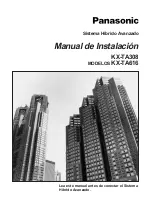
Feature Description
50003510
Revision A
195
Transfer
This feature allows a telephone user, on an established call, to put the call on consultation hold,
dial a third party, and transfer the second party to the third party. The transfer can be done
before the third party answers, after the third party answers, or if the third party is busy.
Transfer Dial Tone
The transfer dial tone feature supplies a tone to indicate that an extension has a call on
consultation hold. Transfer dial tone is returned when an extension places an established call
on hold to consult with another party or to transfer the call. Transfer dial tone is 350/440 Hz,
three bursts of 100 ms on, 100 ms off, followed by continuous tone. Regular dial tone is 350/440
Hz continuous tone.
Transfer Security (Recall)
This feature is designed to prevent the dropping of mishandled calls. If an extension, during
transfer, hangs up before completing dialing, or if the transfer is not allowed, the call that was
placed on hold by the original extension flashing, automatically calls back to that extension.
This also applies to conference calls.
Trunk Answer From Any Station (TAFAS)
This feature allows the user to answer incoming calls appearing at common alerting devices
(night bells). The user can answer calls for a single tenant or for all tenants in the system. The
answering extension can then invoke any feature associated with the incoming call that is
normally available at that extension. TAFAS can also be used to answer certain calls which
ring at the console during the day.
Trunk Circuit Descriptor Options
Trunk circuit descriptors specify the programmable hardware parameters of each trunk circuit
in the system. Each trunk in the system must have a trunk circuit descriptor number with an
associated set of selected options.
Trunk Dial Tone Detection
After accessing a trunk the system tries to detect dial tone on it. If dial tone is detected before
time-out, the system begins sending digits. If no dial tone is detected after the time-out period
and limited wait is specified, the system automatically begins sending digits.
Trunk Groups
Trunk groups are defined and used in the ARS forms in CDE to control extension access to
trunks, to define trunk options, and to apply features to trunk groups.
Trunk Operation - Direct Inward Dial (DID)
DID trunks allow incoming trunk calls to reach extensions without Attendant intervention or
assistance. The length of the incoming number, the number of digits to be absorbed, and a
prefix digit, if required, can also be specified through CDE programming. Calls arriving at the
Содержание SX-2000 EL
Страница 1: ...GENERAL INFORMATION GUIDE LIGHTWARE 19 RELEASE 3 1 ...
Страница 14: ...xiv Revision A 50003510 SX 200 General Information Guide ...
Страница 34: ...SX 200 General Information Guide 20 Revision A 50003510 ...
Страница 61: ...Configuration 50003510 Revision A 47 SX 200 ML Configuration Example ...
Страница 114: ...SX 200 General Information Guide 100 Revision A 50003510 ...
Страница 214: ...SX 200 General Information Guide 200 Revision A 50003510 ...
Страница 226: ...SX 200 General Information Guide 212 Revision A 50003510 ...
Страница 257: ...Glossary of Terms 50003510 Revision A 243 NOTES ...
Страница 258: ... Trademark of Corporation Copyright 2003 Corporation All rights reserved Mitel Networks Mitel Networks ...















































